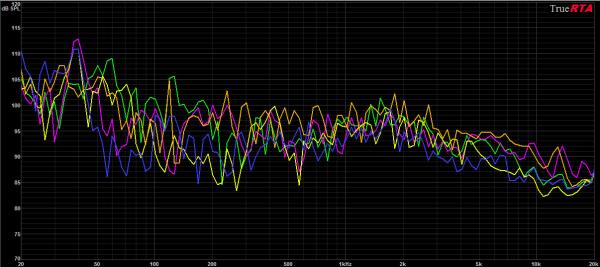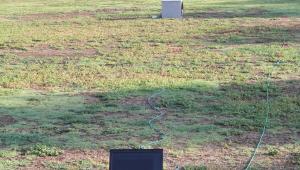The Schroeder Frequency: A Show and Tell, Part 2

In part 1 of this article, we discussed the Schroeder frequency — a frequency above which your listening room works primarily as a sound reflector and diffuser, and below which your room works primarily as a resonator. As I showed in part 1, this is not merely a theory, it's a law of physics, easily demonstrable in any room.
If you read part 1, and you're thinking ahead, you've probably figured out that the existence of the Schroeder frequency has a huge implication for home sound systems. Because bass frequencies react in a room in a completely different way than midrange and treble frequencies do, the place where a speaker delivers the best midrange and treble response in a room is probably not the place where it delivers the smoothest bass response.
The next conclusion you might reach is that it would be a good idea to run the sounds above the Schroeder frequency through speakers positioned for optimal midrange and treble reproduction, and sounds below the Schroeder frequency through one or more subwoofers positioned (and maybe EQed) for optimal bass reproduction. But you'd be only half right.
The human ear can localize sounds (i.e., hear where they're coming from) at frequencies above about 80 Hz. Thus, if you route everything below 200 Hz to the subwoofer, you'll have localization problems with your sub. For example, as Ted Nugent works his way from the high notes on his guitar down to the low notes, approaching the guitar's 82 Hz low E, the sound will seem to move from the midrange/treble speaker to the subwoofer. (I'd prefer to move the sound of Ted's guitar entirely out of my listening room, but I digress.)
Thus, you're best off if you route everything below 80 Hz or so to a subwoofer that's placed to deliver the smoothest bass response in your listening chair. This will mean you're getting less-than-optimum reproduction of frequencies between 80 Hz and your room's Schroeder frequency, but I know of no way to avoid that compromise. Besides, the disruptive effects of the room's resonating properties on your sound system's performance get worse as the frequency gets lower; above 100 Hz or so, there are usually so many resonances that they tend to even each other out to some degree.
Take another look at my room's response in figure 1. See that 40 Hz peak that appears in several of the measurements? That's the primary resonance (or axial mode) of my room at its largest dimension. Using subwoofers and an EQ, I can easily tame it without affecting the midrange and treble. With a typical tower speaker, I could correct the response by running all frequencies through an equalizer, or by using an automatic room correction technology such as Audyssey MultEQ XT. However, most audiophiles who would prefer not to run their music through complicated processing circuitry and algorithms.
It's also worth noting that using two or preferably four subwoofers, placed along the walls or in the corners and properly EQed, has been shown to deliver more consistent performance across a wide range of listening positions than a set of full-range speakers can. By the way, here's an article with more about placement of subs and use of multiple subs (PDF link).
God vs. audiophilesWhat I've prescribed here flies in the face of typical practice among two-channel audiophiles. Most of them prefer to run all the sound - bass, midrange, and treble - through a pair of large, full-range tower speakers without equalization. It should be obvious, though, that God - or whatever or whoever created the laws of physics - would not consider this to be the optimal arrangement. A typical pair of tower speakers, placed in the spots that deliver the strongest and most realistic stereo image in the midrange and treble, is not placed for the smoothest bass response.
(That said, as I implied before, all tower speakers can be equalized, and a few can be equalized in just the bass without affecting midrange and treble. Any tower speaker with a built-in subwoofer that includes a line-level input, or any tower speaker with speaker-cable binding posts that allow the bass section to be separately amplified, can be optimized for smooth bass response in your listening chair even if the speakers are placed for the best midrange/treble performance. All you have to do is connect a low-frequency equalizer such as the MiniDSP, then dial in the EQ for flat bass response.)
Thus, most systems running well-engineered, full-range tower speakers produce great sound above the Schroeder frequency, but uneven response below it. So why haven't audiophiles junked their tower speakers and embraced subwoofers? For lots of reasons, some good, some bad.
1) Some complain that it's too difficult to get a smooth transition between the subwoofer and midrange/treble speaker. My admittedly flippant response is, "Well, too difficult for them, maybe" - the implication being that they haven't tried very hard. With so much good, low-cost measurement gear available nowadays, it shouldn't be all that difficult for anyone to set up a subwoofer crossover. Besides, the logic that says the transition between the subwoofer and midrange/treble speakers must be flawless but that colossal dips and peaks in the bass response are somehow acceptable completely escapes me.
2) Some associate subwoofers with low-quality, boomy bass. Back in the mid-1990s, when only a few companies had figured out how to make good subs, there might have been some truth to that assessment. But now there are countless subwoofers - most notably those from specialists such as Hsu Research, SVSound, and Velodyne - that can outperform the bass sections of most tower speakers. The best bass I heard at last year's T.H.E. Show in Newport Beach came not from a $20,000 tower speaker, but from Hsu Research's $879 VTF-15H subwoofer. Dr. Hsu was, of course, free to place his sub at whatever spot in the room gave him the best bass performance - a freedom that the guys demoing tower speakers didn't have.
3) Most stereo audio preamps and integrated amps don't incorporate a subwoofer crossover. This is a pathetic state of affairs, especially when you consider that a fixed 80 Hz crossover requires just a few simple active filters, each of which is composed of a basic preamp stage (or a single channel of an op amp) plus a handful of inexpensive capacitors and resistors. Fortunately, good line-level crossovers are built into many high-end subwoofers, and they're readily available in the pro audio market.
4) Tower speakers are easier and more convenient to install than subwoofers. Can't argue there.
5) Tower speakers look nicer than a big subwoofer. Well, beauty is in the eye and all that.
6) I've saved what I think are the most important reasons for last: tradition, orthodoxy, and anti-science bias, all of which hold power over some audiophiles.
If you want to learn more about the Schroeder frequency, read the book by the guy who's arguably done the most to call Schroeder's work to the attention of the audio industry: Sound Reproduction: The Acoustics and Psychoacoustics of Loudspeakers in Rooms by Dr. Floyd Toole.
- Log in or register to post comments






























































